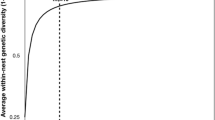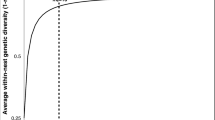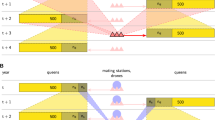Abstract
A number of hypotheses have been proposed to explain the evolution of multiple mating in the honeybee queen. In particular, the consequences of reduced intracolonial relatedness provide plausible explanations for multiple mating with up to ten drones, but fail to account for the much higher mating frequencies observed in nature. In this paper, we propose an alternative mechanism which builds on non-linear relationships between intracolonial frequencies in genotypic worker specialization and colony fitness. If genes for any worker specialization confer an advantage on colony fitness only when they are rare, this would require a stable mix of sperm from a few drones which contribute that trait, and many which do not. To ensure both specific, low within-colony proportions of “rare specialist” genes, and to reduce random variation of these proportions would require mating with high numbers of drones. The quantitative implementation shows that moderate to very high numbers of matings are required to exploit colony advantages from genotypic allocation of workers to rare tasks. Extreme polyandry thus could result from colony selection dependent on the intracolonial frequency of rare genetic specialists.
Similar content being viewed by others
Author information
Authors and Affiliations
Additional information
Received: 30 January 1998 / Accepted after revision: 7 October 1998
Rights and permissions
About this article
Cite this article
Fuchs, S., Moritz, R. Evolution of extreme polyandry in the honeybee Apis mellifera L.. Behav Ecol Sociobiol 45, 269–275 (1999). https://doi.org/10.1007/s002650050561
Issue Date:
DOI: https://doi.org/10.1007/s002650050561




